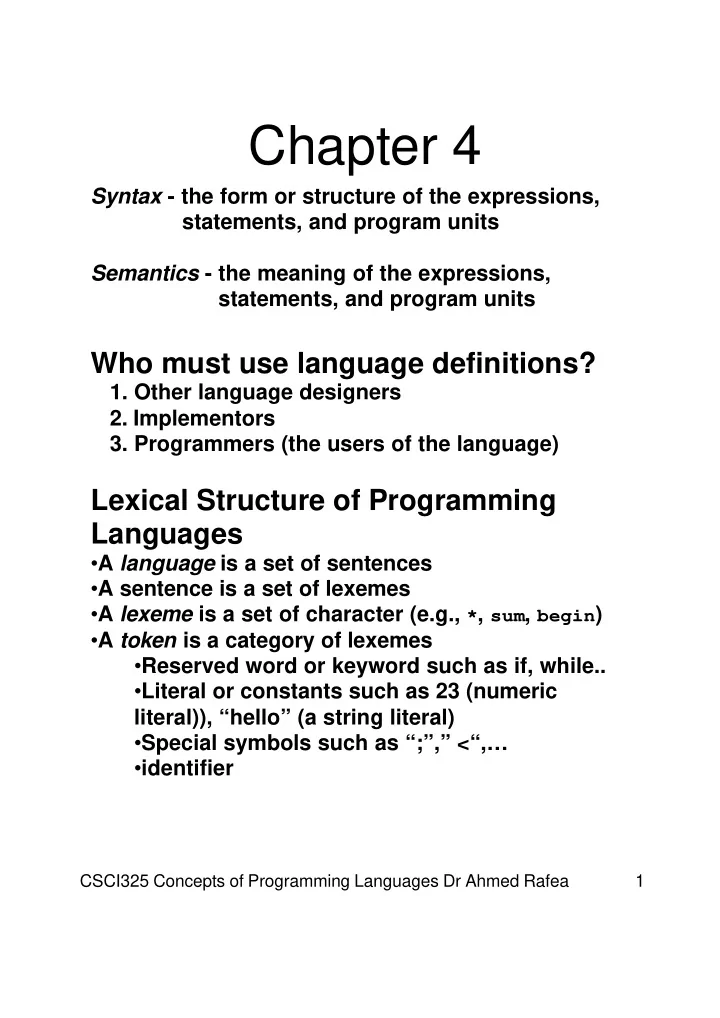

Chapter 4 Syntax - the form or structure of the expressions, statements, and program units Semantics - the meaning of the expressions, statements, and program units Who must use language definitions? 1. Other language designers 2. Implementors 3. Programmers (the users of the language) Lexical Structure of Programming Languages • A language is a set of sentences • A sentence is a set of lexemes • A lexeme is a set of character (e.g., * , sum , begin ) • A token is a category of lexemes • Reserved word or keyword such as if, while.. • Literal or constants such as 23 (numeric literal)), “hello” (a string literal) • Special symbols such as “;”,” <“,… • identifier CSCI325 Concepts of Programming Languages Dr Ahmed Rafea 1
Chapter 4 Context-Free Grammars - Developed by Noam Chomsky in the mid-1950s - Language generators, meant to describe the syntax of natural languages - Define a class of languages called context-free languages Backus Normal Form (1959) - Invented by John Backus to describe Algol 58 - BNF is equivalent to context-free grammars A metalanguage is a language used to describe another language. In BNF, abstractions are used to represent classes of syntactic structures--they act like syntactic variables (also called nonterminal symbols ) e.g. <while_stmt> -> while <logic_expr> do <stmt> This is a rule ; it describes the structure of a while statement CSCI325 Concepts of Programming Languages Dr Ahmed Rafea 2
Chapter 4 A rule has a left-hand side (LHS) and a right-hand side (RHS), and consists of terminal and nonterminal symbols A grammar is a finite nonempty set of rules An abstraction (or nonterminal symbol) can have more than one RHS <stmt> -> <single_stmt> | begin <stmt_list> end Syntactic lists are described in BNF using recursion <ident_list> -> ident | ident, <ident_list> A derivation is a repeated application of rules, starting with the start symbol and ending with a sentence (all terminal symbols) CSCI325 Concepts of Programming Languages Dr Ahmed Rafea 3
Chapter 4 An example grammar: < program> -> <stmts> <stmts> -> <stmt> | <stmt> ; <stmts> <stmt> -> <var> = <expr> <var> -> a | b | c | d <expr> -> <term> + <term> | <term> - <term> <term> -> <var> | const An example derivation: < program> => <stmts> => <stmt> => <var> = <expr> => a = <expr> => a = <term> + <term> => a = <var> + <term> => a = b + <term> => a = b + const Every string of symbols in the derivation is a sentential form A sentence is a sentential form that has only terminal symbols A leftmost derivation is one in which the leftmost nonterminal in each sentential form is the one that is expanded A derivation may be neither leftmost nor rightmost CSCI325 Concepts of Programming Languages Dr Ahmed Rafea 4
Chapter 4 A parse tree is a hierarchical representation of a derivation <program> <stmts> <stmt> <var> = <expr> a <term> + <term> <var> const b A grammar is ambiguous iff it generates a sentential form that has two or more distinct parse trees CSCI325 Concepts of Programming Languages Dr Ahmed Rafea 5
Chapter 4 An ambiguous expression grammar: <expr> -> <expr> <op> <expr> | const <op> -> / | - <expr> <expr> <expr> <op> <expr> <expr> <op> <expr> <expr><op><expr> <expr><op><expr> const - const / const const - const / const If we use the parse tree to indicate precedence levels of the operators, we cannot have ambiguity An unambiguous expression grammar: <expr> -> <expr> - <term> | <term> <term> -> <term> / const | const <expr> <expr> - <term> <term> <term> / const const const CSCI325 Concepts of Programming Languages Dr Ahmed Rafea 6
Chapter 4 <expr> => <expr> - <term> => <term> - <term> => const - <term> => const - <term> / const => const - const / const Operator associativity can also be indicated by a grammar <expr> -> <expr> + <expr> | const (ambiguous) <expr> -> <expr> + const | const (unambiguous) <expr> <expr> + const <expr> + const const Extended BNF (just abbreviations): 1. Optional parts are placed in brackets ( [] ) <proc_call> -> ident [ ( <expr_list>)] 2. Put alternative parts of RHSs in parentheses and separate them with vertical bars <term> -> <term> (+ | -) const 3. Put repetitions (0 or more) in braces ( {} ) <ident> -> letter {letter | digit} CSCI325 Concepts of Programming Languages Dr Ahmed Rafea 7
Chapter 4 BNF: <expr> -> <expr> + <term> | <expr> - <term> | <term> <term> -> <term> * <factor> | <term> / <factor> | <factor> EBNF: <expr> -> <term> {(+ | -) <term>} <term> -> <factor> {(* | /) <factor>} Syntax Graphs - put the terminals in circles or ellipses and put the nonterminals in rectangles; connect with lines with arrowheads e.g., Pascal type declarations type_identifier ( identifier ) , constant .. constant CSCI325 Concepts of Programming Languages Dr Ahmed Rafea 8
Recommend
More recommend